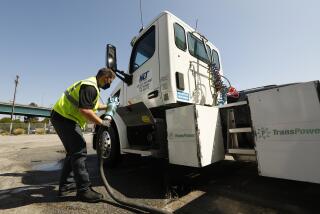Older tractor-trailers are given new life on the road
- Share via
Louisville, Ky. — It’s not the prettiest truck in the lot, but its time has come to shine.
Beside the gleaming new tractor-trailers on display at the Mid-America Trucking Show here last week, a 3-year-old semi with 390,000 miles took an unlikely place on center stage.
This particular Navistar International Corp. model just got a $19,000 face-lift, including new tie rods and curtains in the sleeping cab behind the driver’s seat. Those parts should hold up for three more years of heavy use, and, with luck, the engine could go 1 million miles in all.
The best part, at least for buyers: It’s a lot cheaper than paying more than $100,000 for a new one.
And that’s the point in a business that makes the automobile industry look somewhat robust.
Highway trucks have been a tough sell, with 2009 marking the biggest sales drop in decades.
“This year will be better, but not good,” said Martin Daum, president of Daimler Trucks North America, which makes the Freightliner brand. “2010 for us is still a complete recession.”
It’s no wonder: Fuel costs are high, shipping rates low and freight traffic only beginning to pick up again. Government regulations for 2010 require costly emissions equipment, making new-vehicle purchases a bigger gamble.
Those factors have combined with tight credit to sideline the independent owner-operators crucial to the long-haul trucking industry. Fleets are becoming ever more important, but their economics have eroded as well.
Many had gotten into the habit of replacing their trucks every couple of years, not only to avoid maintenance and downtime but also for tax advantages. As activity ground to a halt, those pricey late-model vehicles were worth less in the marketplace than the loans taken out to buy them. Trading them in would mean booking a loss.
Warrenville, Ill.-based Navistar has responded by launching a reconditioning program, aiming for incremental revenue from parts and repairs, at the risk of undermining new-truck sales to fleets.
“They weren’t going to buy anyway,” said Chief Executive Daniel Ustian. “This is our way to keep them as a customer.”
Much of the industry, in fact, has focused on making do.
Driver and mechanic Richardson Jacobs, of Lebanon, Ohio, does the same upgrades on a small scale that Navistar will be doing on 100 trucks at a time for fleet owners. Prices for his services have plunged, partly because many truckers lack the funds for such work as rebuilding an engine, Jacobs said at the show.
“The way the economy is now, everybody wants to haggle,” Jacobs said.
Predictably, the average age of big trucks on the highway has hit record levels, and with so few 2009s, 2010s and 2011s being sold, it’s likely to keep rising.
Spending $20,000 to extend the life of a 3-year-old truck that otherwise would sell for only $30,000 or so makes good financial sense, especially since new trucks offer less relative value than in the past, said analyst Noel Perry of FTR Associates research firm.
Some of the traditional benefits of buying new -- durability, power and fuel economy -- have been offset by emissions controls and efforts to conserve cash.
Perry expects annual sales in the industry to rise 10% or 11% over a dismal 2009, “a terrible year by any measure,” he said. “People start replacing trucks when freight gets strong. That’s two or three years into an economic recovery.”
Truckmakers, generally, voice greater optimism.
These big machines do wear out, after all. And rising diesel prices will make newer models worth the investment based on fuel economy alone, Daum said. Aerodynamic designs, lighter weights and more efficient drive trains will help bring about a 10-mile-per-gallon improvement over the next decade, he predicted.
That will lure buyers in droves to rekindle the marketplace for new trucks -- eventually.
“The more it goes down,” he said, “the more it goes up one day.”
Burns writes for the Chicago Tribune.
More to Read
Inside the business of entertainment
The Wide Shot brings you news, analysis and insights on everything from streaming wars to production — and what it all means for the future.
You may occasionally receive promotional content from the Los Angeles Times.










